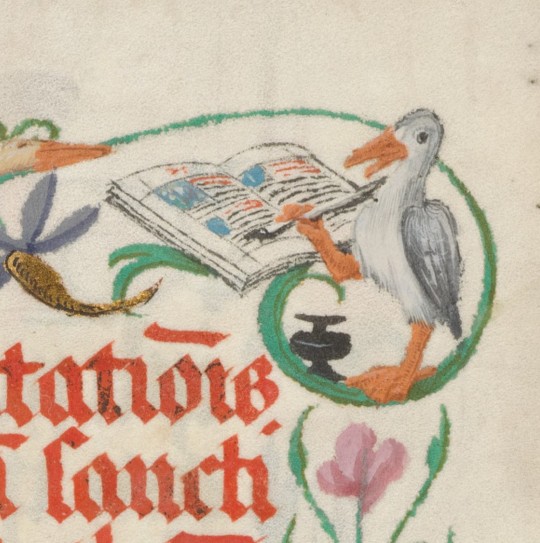#scribes
Explore tagged Tumblr posts
Text




3 more desert skeletons! all boys this time. each on the ah for 50kt, find them at the bottom of this tab
@fr-boosts
23 notes
·
View notes
Text

For centuries, the image of a monk hunched over a manuscript, painstakingly copying text by candlelight, has dominated perceptions of medieval book production. However, a recent study has provided the first quantitative analysis of female scribes’ contributions to manuscript copying, revealing that women played a small but steady role in this field. Published in Humanities and Social Sciences Communications, the research estimates that at least 110,000 manuscripts were copied by female scribes during the Middle Ages, with around 8,000 still surviving today.
Click here to read more
566 notes
·
View notes
Text

11/08/2024
Shutter your windows, you shuddering widows.
___
JOKE-OGRAPHY: 1. In this Bible story, Jesus warns His followers against teachers who value their status more than their mission. They wear long, rich robes to show off their status. They go out to marketplaces to be recognized and greeted. They receive seats of honor at lavish banquets. They recite lengthy prayers in public to impress people with their piety. Yet, when entrusted by law with helping to manage the assets of grieving widows, they take advantage and cheat them out of their property (Jesus says they "devour the houses of widows" in most translations). These hypocrites like to LOOK good instead of BEING good, and Jesus says that'll earn them a terrible punishment. 2. In this cartoon, Jesus says His line from the Bible, ending with, "Yet they devour the houses of widows." He's explaining how the hypocritical teachers take advantage of people, and a nearby widow quietly listens and concurs. Suddenly, a flock of hypocritical teachers descends to feast upon her home, and she's forced to fight the literal embodiment of Jesus's figurative speech. 3. I've said it before, but using straight up verbs as onomatopoeias is super funny to me, and a lofty scholar hissing while he's thwacked by a broomstick is surely novel, right?
#catholic#christian#jesus#comic#cartoon#catholic memes#christian memes#jesus memes#tomics#bible#tom gould#tomics comics#mark 12#widows#scribes#teachers#pharisees
369 notes
·
View notes
Text


Hello little guy 👋
#morrowind#nerevarine oc#I refuse to kill these cuties#nerevarine#elder scrolls#elder scrolls fanart#tes#my art#drawing#dunmer#scribes#morrowind fanart#digital arwork#digital fanart#fanart#morrowind art#dunmer oc#oc drawing#elf oc#rainyday#oc elder scrolls
488 notes
·
View notes
Text

Goddess of Writing, Wisdom, Knowledge, Sciences, Accounting, Architecture, Astronomy, Astrology, Building, Mathematics, and Surveying.
Divine measurer, Scribe and Record Keeper of the Pharaoh.
The Inventor of Writing.
Mistress of the House of Books.
Mistress of Builders.
#deity worship#devotional#devotional post#kemetic polytheism#kemetic#kemetism#kemetic deity#seshat#wisdom#kemetic paganism#kemetic prayer#knowledge#writing#goddess worship#god worship#ancient kemet#egyptian gods#egyptian goddess#ancient egypt#egyptian deities#scribes#polytheistic#pagan polytheism#egyptian polytheism#pagan polytheist#pagan#lion#cheetah#omnist#pantheism
92 notes
·
View notes
Text



clerics & scribes
from the margins of a "pontifikallektionar", a liturgical manuscript made for abbot peter eichhorn ("peter squirrel"), wettingen (switzerland), 1557
source: Luzern, Staatsarchiv, Pontifikallektionar, fol. 10r and 10v
#his last name isn't exactly the same word as squirrel but it's close. it's squirrel (eichhörnchen) minus the diminutive#16th century#marginalia#squirrels#scribes#manuscripts#pontifikallektionar#peter eichhorn#illuminated manuscript
370 notes
·
View notes
Text
Onyx Storm, Chapter 13:
Upon failure of three exams, Jesinia Neilwart has been removed from the adept path and stripped of all its responsibilities and sacred privileges as of January 15. Under protest, transfer her command to Professor Grady at his over-authoritative request. — Official Records: Scribe Quadrant, Colonel Lewis Markham, Commandant
Fourth Wing, Iron Flame, and Onyx Storm:
The following text has been faithfully transcribed from Navarrian into the modern anguage by Jesinia Neilwart, Curator of the Scribe Quadrant at Basgiath War College. All events are true, and names have been preserved to honor the courage of those fallen. May their souls be commended to Malek.
— Doesn’t this mean Jesinia did NOT fail and is STILL in the scribe quadrant? Or she at least makes her way back?! —
#Onyx Storm#Iron Flame#Fourth Wing#The Empyrean series#Rebecca Yarros#Jesinia Nielwart#Scribes#Scribe Quadrant#Curator of the Scribe Quadrant#Basgiath#Basgiath War College#Chapter 13#prologue#technical opening#Navarrian#Professor Grady#Quest Squad#Colonel Lewis Markham
29 notes
·
View notes
Text


Leshy! (finished sketch)
I almost forgot how peak inscryption was and I'm so annoyed I forgot about leshy and the moon fight
which one do you prefer?
#leshy#inscryption#leshy inscryption#inscryption fanart#inscryption leshy#leshy fanart#digital art#krita#art#drawing#artwork#scribe of the beasts#scribes
44 notes
·
View notes
Text

#bible study#jesus loves you#heal me of god#gods bless#who is god#may god help us all#biblical scripture#scripture verses#verse of the day#king james version#bible verse#free verse#verses#bible scripture#bible scriptures#scribes#jesus is the truth#jesus christ#jesus is life#faith in jesus#jesus love you#jesus is coming#jesus#just relax#joy#pray prayer praying prayers jesus help hope trust christian christianity christians jesuschrist faith#god#faith in god#faith based conetent#faith content
78 notes
·
View notes
Text


I started my calligraphic quests in June 2023. This is my work as of the 10th of January, 2025. I hope to capture my journey in calligraphy and my love of letterforms here. Wish me luck!
27 notes
·
View notes
Text
okay. red and green (unnamed cerdae) were protectors of this massive underground tree that grew at the death site of a terra tortoise aaages ago. they were essentially progens and protectors of a small village that was around it, and were like. minor deities. over time the dragons began to abandon the tree to live upon the surface (as early post-pillar-break tensions between the eleven settled), but red and green couldnt go far from their tree, alone save for what terra tortoises still live in the area, and each other of course. (warning: not scientificaly accurate) over time as leylines changed the great tree began to fossilize, inducing a torpor in its cerdae. the tree petrified, its guardians fell into a deep sleep, their pearls lost over the years. when the leylines shift once more, it traces a path beneath the tree, and as it has done with the bones in the cairnstone rest the tree is given new life--and its cerdae awake. but they are much, much stranger now.


#scribes#flight rising#pearl cerdae#and then osmund finds them and the tree#and the tortoises#and is like wow what a monumental find for archeobiology!#shame he cant tell anyone bc the cerdae think hes cute and want to smooch him.#and he doesnt want his grandma to get mad but he Does want smooches#anbar#silas
62 notes
·
View notes
Text
20 Essential Tools of a Medieval Scribe

From ink-stained fingers to feline assistants, medieval scribes relied on an eclectic mix of tools to craft their manuscripts—some practical, some unexpected.
Click here to find out
43 notes
·
View notes
Text
Fortis 1.2
Part One Part Two Part Three
Same warnings. I’m not going to repost them every part.
Disclaimer, foundation is still being set. Most of Bria and Garrick’s squad is introduced here. And Bria still doesn't have a pairing. I only only the OC's, Rebecca Yarros owns everything else.
Word count: 2400+
🔥🔥🔥
Moray was quick to quite literally pile drive us through the crowds and out of formation, until we made it somewhere out of the way in the long halls, somewhere quiet and almost secluded even. Garrick Tavis, having been the only one close to me at the back of our squad, had made quick work of picking me up by my forearms and walking me a few steps when the pushing hit hard. He had saved me from tripping and getting trampled, but it still pissed me off. I wasn’t a sack of rice to be hauled around.
“Okay kiddos,” Moray claps his hands twice, looking around the circle we managed to create, most of our backs to the wall. “Everyone should’ve been given some type of academic schedule by now. If you haven’t… share with a friend.”
“What friends?” Someone mouths off, sarcasm dripping heavily.
“These friends.” Moray gives a pointed look to each of us. “The people you see here are the only ones not out to kill you. You don’t have to like them, but trust in your squad and work together. My best advice to be honest. Only some of you will make it to third year and possibly even graduate, if you’re lucky. But not all of you. We’ll see more survive if you can grow up and stop being crybabies and maybe even put some differences aside and work together here and there.”
“You shoved us in the hall to make us take friendship vows Moray?” Another smartass speaks up, this one was on the other side of Tavis, though he gave Tavis a solid foot of space. A curtesy Tavis hadn’t given me. The smartass was tall, had wavy dirty blonde hair and dark eyes. And he was scarred... His tanned skin was littered with marks anywhere skin showed. Even his throat.
Moray rolls his eyes. “No dumbass --”
A few people snort.
“I called you hear to let you know I’m not holding your hands. Don’t expect anyone to come save you. You want to live? Get better. Get smarter. Don’t make enemies off everyone you meet.” Moray shoots the second year a dark look, “I expect you all of people to understand that, Deirdre. Don’t teach the first years any bullshit either.”
Deidre holds Moray’s gaze. Clearly clocking the threat in the under tone of Moray’s words. The stare off lasted seconds before Deidre nodded, crossing his arms and leaning back against the wall.
Then just like that, I blinked, and the hardened exterior Moray had put up was gone. “Like I said, all of you should have a schedule. Classes don’t begin until tomorrow morning. You’re free to explore today- or hide. I don’t care. First years, I would suggest staying in pairs or buddying up, but if you don’t care I don’t care. All of you first years also do have to sign up for assignments sometime here soon. If you wait till the last minute don’t be surprised that you get a shit assignment.”
“So, we’re free to go then?” The puker asks, his hand caught mid raise, like he didn’t know if it was safe to lift it or not.
“Yes Eithne. Unless there are any questions.” Moray nods. He stood tall, rolling his shoulders and crossing his arms across his broad chest. I’d bet this guy lived in the gym sparring and lifting weights last year.
The first-year smartass laughs, shoving his shoulder with his own. “Why are you such a coward? No dragon is going to want to bond that.”
“And what dragon is going to want to bond a dumbass like you, Rois?”
All eyes shoot this way. My direction, but they’re not looking at me. It was Tavis who spoke up.
The squad was stunned into silence. I didn’t dare move and lessened my breath intake to not draw attention to me.
Those who had stood in front of me blocking Rois from my view had moved. Giving a clearing between him and Tavis should either decide to lunge. Rois was Tavis’s height, but Tavis was much bigger than Rois. And while Tavis stood tall and sure, hands casually in his pockets. Rois looked unsteady, a slight tremble went up his hands. Whether it was nerves or fear I didn’t know. Then Rois’ gaze flicked down to me.
Don’t you fucking dare --
“Come on Sorrengail,” Rois’ mouth lifts to a smirk. “Wouldn’t you agree? Dragons won’t bond people like–"
“I wouldn’t presume to speak for the dragons.” I cut him off haughtily. Anger surged through me. Quickly turning into a simmering rage, that flooded my veins and clouded my head. Whatever damper I had put on my emotions was coming to an end. And it seemed my temper was returning tenfold. “Dragons bond for reasons humans could never understand. Anyone with half a wit would know better than to try and speak for one.”
There was a gasp or two.
“Why are you siding with that- that-” Rois was turning red. He took half a step forward, flinging his arm in Tavis’s direction. Tavis too, took a step forward, casually angling his body and blocking me from seeing Rois momentarily. “That traitor.” He all but yelled it.
“Traitor?” My tone took a tilt I hadn’t heard in a while. One that only came out when I was long overdue to destroy something. “Has he done something Leadership should be aware of?” I sidestepped Garrick. Rois froze. Clearly caught and cornered. “If so, please do go find someone quickly. Mind you,” the corner of my mouth twitched upwards. “Leadership isn’t going to care about your frail masculinity or fragile ego. So, before you go crying to them, think to yourself is this something they’re actually going to care about? Because if the answer isn’t a firm yes, backed up with the Riders Codex or Code of Conduct… you’re better off throwing yourself from the turrets upstairs. Or perhaps the parapet? Or maybe even finding the nearest dragon and offering yourself as a humble sacrifice.”
A few people laughed. The little voice in the back of my head – logic – was saying shut the fuck up you dumb bitch, but I ignored it, per usual. Because I was emotional, and angry and my self-control apparently shit.
“So how about you shut the fuck up so we can all move on with our day?” I ask, shrugging my shoulders with a hint of dramatic flair. “And maybe remember to think before you speak next time? Or perhaps make sure you have the right audience for whatever bullshit you want to start next?”
Rois was breathing heavily now, his jaw clenched so tightly there was a tic on both sides. “How about you shut the fuck up?!”
I move forward again. “Or what? Cause you’re sure as fuck not about to beat me the fuck up. So how about you shut the fuck up, before you get beat the fuck up?”
Most of the squad laughed now. Even Moray seemed to chuckle, shaking his head. He steps forward though into the center of the group, and I back up, not having realized I stepped forward in the heat of my anger. Tavis also stepped back against the wall, and I noticed there was a third year who also had to move back and two second years who moved away as well. Had this little debacle really been about to stir up our entire squad into a group fight? This squad was fucked.
“Okay kids,” Moray lifts his hands. “This was exactly what I was just talking about.” He looks pointedly between Rois, Tavis and me. “You do not have to like each or be besties. But you will have to learn how to cohabit shared spaces. So, let’s try to get along. Also let’s try not to draw attention to ourselves by throwing around empty accusations and maybe even try not to speak for the dragons. They prefer to speak for themselves. So, let’s all agree to disagree and move on for the day.” Moray looked around to everyone now, waiting for any rebuttal or anything else that may come. “Perfect, you’re dismissed. Third years don’t forget your third-year shit and second years don’t forget your second year shit. Do try to keep the children alive if you can.”
Everyone nods and starts dispersing.
“And go get your regulation uniforms!” a third yells, I jump, moving further back. The fuck? “Line is going to be long and if you need a popular size, you’re going to want to go quick or end up in shit that doesn’t go. Then go to dinner and find your bunks!”
“Right,” Moray nods, rubbing the back of his neck sheepishly. “Forgot about the uniforms.”
“Happens to the best of us,” the third year closest to Moray is tall and littered in patches.
I hate that everyone is so tall. I wasn’t even the shortest person here, I had seen one girl an entire head shorter than me, and even some guys who were right around my height.
The third-year locks Moray into a headlock and starts ruffling his hair. “Hard to believe you’re all grown up and not a little kid anymore.”
“Erin fuck outta here!” Moray pushes Erin’s hands off him. “You’re going to scare the children.” Both their eyes moved to us first years who hadn’t moved. It was me, Tavis, Eithne, and two other first years. A girl I hadn’t even noticed yet. She was even taller than me, she looked like she’d never worked out before. So, I won in that department. And a boy who stood awfully close to her, grinning.
“Perhaps we should’ve started with introductions.” Moray says, though it was partially under his breath.
The third years laughed, “after that spectacle last year? No way.” The third year who reminded us about the uniforms looked closer at the group remaining.
“I forgot how awkward first years were.” The one female third year in our group sighs. “I’m Aoife.” She was tall and slender. But when she rocked from one foot to the other casually muscles rolled underneath her tight black uniform. She was brunette, and her hair was cut at her shoulders. A manageable length, one that could be tied back or left alone. And tanned. She spent plenty of time in the skies. Her skin was flawless. She shoves her elbow into the third year beside her. Average male height, bulky, slow and rigid as he stretches his thick arms over his head.
“Conner. Welcome in kiddos. Don’t be shy if you have questions. Your squad is the best to ask, you might get hazed a little but it's all in good fun.” Conner smiles, it felt genuine, but something about him said trouble.
Analyze everything yourself Bria. My dad’s reminder made my heart throb. Did he know mom took me to the Riders Quadrant and not the Healers like he had said to. I hadn’t even gotten a chance to tell him bye. He had been gone the last few weeks doing some scribe stuff elsewhere, mom had said I wasn’t privy to the details. But he had taken Violet with him. So, it couldn’t have been that secretive, right?
Something akin to insecurity settled in my gut as I last track of here and now. When would they return? What would mom even say to them? My younger sister had hugged me so tightly when she had left, beaming at me as she explained how excited she was about this new book from Mira she had gotten for her birthday. Did Mira even know? Surely not… right… My older sister would’ve warned me before she left for her new station. Having just freshly graduated from this very college in the last couple weeks. I missed them both so much.
Was I not good enough for the Healers Quadrant? I had studied for years in the library while my dad and Violet did their little scribe stuff. Why couldn’t they just tell me.
Tavis shifted beside me, drawing my attention and snapping me out of my self-depreciating thoughts. I took a deep breath to center myself, ignoring the calculating look Aoife was giving me.
There were fifteen people in my squad. Three of them were third years. Aoife, Conner and Erin. They seemed close enough, as I glanced between them, noting their laid back positionings. There were four second years. Only two stood in the group here. Our Squad leader, Moray. And Deidre. Who I couldn’t get a clear reading on. There seemed to be something tense between the two, some familiarity that we weren’t in on. Who were the other two second years? I should’ve been paying attention, I hadn’t even looked at my squad entirely.
“Brandon.” The first-year guy says, and he still had that wide grin on his face like he was so happy to be here. Asshole. He bumped his side into the girl beside him, her head shooting up and staring at him wide eyed.
“I’m Kayleigh Murphy.” She tipped her glasses up her freckled nose, pushing her light blonde hair behind her ears and blinking between each of us. She almost looked as if she wanted to say something else, but instead she just tipped her chin down, flushing a deep red in clear embarrassment.
Three third years, and four second years, that left eight first years. Here with me stood Tavis, Eithne, Brandon, Kayleigh. Rois was one, but the other two were unknown to me. That left four squad mates I had no clue about. My father would not approve of my negligence, and something told me my other two Rider siblings wouldn’t either. Wasn’t smart. Wasn’t strategic. I could hear it now, could see the crossed arms and shaking heads. Mira would kick my ass, and Brennan would lecture me into an early grave.
“Nice to meet you.” Brandon winks, chuckling at the girl’s reaction. He shook his head, wavy black hair flopping from left to right. He wrapped an arm around her, and she turned even more red and began stammering.
Tavis snorts beside me, side-eying me and that humorous glint in his hazel eyes was back. “Garrick Tavis.”
I reared back, “don’t even think about it asshole.” The group laughed, as I moved out of reach and started on my way.
“Wait!” Moray hollered after me, “you didn’t introduce yourself.”
“I don’t have to,” I call over my shoulder, long hair swishing left to right. “You already know who I am.”
🔥🔥🔥
later on in the third-years hall
“She’s a total badass.” Conner declares loudly.
“She’s kinda hot.” Erin adds.
“Not you two third years showing your immaturity over a first-year right now.” Aoife rolls her eyes.
#fourth wing#fourth wing x reader#garrick tavis#iron flame#onyx storm#wingleader#violet sorrengail#brennan sorrengail#mira sorrengail#lilith sorrengail#asher daxton#asher sorrengail#scribes#riders quadrant#dragon oc#dragon#the empyrean
22 notes
·
View notes
Text

11/01/2024
Happy All Saints' Day!
JOKE-OGRAPHY: 1. In this Bible story (Mark 12:28-34), Jesus is teaching a crowd and answering the riddles and objections of scribes who want to trip Him up. In the end, one scribe pipes up and asks a genuine question: "Which is the greatest commandment?" Jesus gives a twofold answer, which boils down to, "Love the one true God above everything, and love your neighbor as yourself." Though simple, this sums up all the laws and prophets. The scribe is impressed by Jesus's answer and agrees that these two commandments are worth more than any sacrifice prescribed by the law. Jesus sees this scribe's understanding and commends him by telling him he's not far from the Kingdom of God. After that, no one else dares to ask any more questions. 2. In this cartoon, the Bible story progresses as normal until the ending. When Jesus tells the scribe he's not far from the Kingdom of God, the scribe instead assumes Jesus means he's not far from heaven, which you only go to when you die. Thus, the scribe thinks Jesus is threatening to kill him, and the crowd decides not to ask any more questions, lest they too be caught up in the Lord's mighty wrath. Of course, they are all mistaken, which is funny.
#jesus#catholic#christian#comic#cartoon#catholic memes#christian memes#jesus memes#tomics#bible#tomics comics#tom gould#scribes#mark 12#imminent murder
293 notes
·
View notes
Text
Ok this is important
Whose the sexiest act 1 Boss of Inscryption?


Whose gonna be Inscryptions next top model?
#no baldness no extra options#just pick one#my husband posed the question and i figured Tumblr would know#inscryption#scribes#inscription#inscryption prospector#inscryption angler#Inscryption trapper#inscryption trader#leshy#Inscryption leshy#phase 1#act 1
20 notes
·
View notes